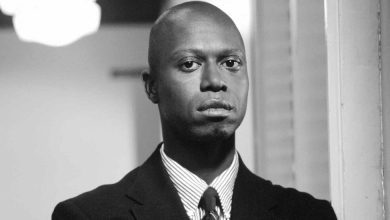Review: Dance Theater of Harlem’s Soulful Ballet to Stevie Wonder

Dance is perfectly capable of saying something all by itself, but music can help. Sung lyrics are more perilous, introducing the threat of literalism, yet the combination of dance and words, handled right, can heighten meaning. One example: Robert Garland’s intensely affecting “Higher Ground,” which had its New York premiere this week when Dance Theater of Harlem returned to New York City Center.
Garland, the company’s resident choreographer, has chosen six songs from the 1970s catalog of Stevie Wonder. This was a period in which Wonder’s musical genius was exploding, his astonishing creativity fueled by outrage at racial injustice, which he addressed directly in his lyrics. Just the titles of Garland’s first three selections convey the gist: “Look Around,” “You Haven’t Done Nothin’,” “Heaven Is Ten Zillion Light Years Away.”
That social commentary, soulful and funky, is what the dance is about. The dancers look around, form circles and chains, point fingers and fall backward. As in the music, there are signs of strength and hope. When the Jackson Five add their voices to sing “doo-doo-wop,” Garland offers a dance equivalent, all rolling hips and shoulders. When Wonder sings of opening your heart to feel the spirit, Garland has the dance language for the gospel lift.
Combining Black vernacular dance with classical ballet, as Garland does here, has long been his signature. But it is ballet alone that he applies to devastating effect in the next track, “Village Ghetto Land.” In that song, Wonder plays tour guide, setting up a sarcastic contrast between stately baroque accompaniment and lines about starving people eating dog food and babies dying before they’re born, “infected by the grief.” Garland has Amanda Smith rise on pointe and behave like the Sugar Plum Fairy welcoming us into the Land of Sweets. The pureness of her technique sharpens the sarcasm to an almost unbearable point.
Then Garland offers a vision of escape with the final songs “Saturn” and “Higher Ground,” employing all of ballet’s gravity defiance, its thrilling lifts and catches (perfectly executed by Alexandra Hutchinson and Kouadio Davis) and the spatial formations of a classical finale, all to Wonder’s funk metal. In this context, those conventions are reinvested with meaning and emotion, the joy and fun deepened by the knowledge of pain.
In places, Garland doesn’t trust enough in the formal power of his choreography and underlines with obvious gestures. But he has something important to convey. “Look around,” this ballet says; look at what hasn’t changed since the ’70s. But it also says, “look around,” Dance Theater of Harlem, just getting started in those years, is still going, still claiming the language and beauty of ballet for Black dancers.
After this high, the rest of the program on Friday, though nicely varied, had a gently downhill slope. Claudia Schreier’s “Passage,” also receiving its New York premiere, was made in 2019 to commemorate the 400th anniversary of the arrival of enslaved Africans in America. But it handles its subject more abstractly, closely attuned to a dramatic commissioned score by Jessie Montgomery, played live by a chamber ensemble.
It begins in watery illumination (by Nicole Pearce), with women lifted and undulated like waves. When the score accelerates and bounces like a ship at full speed, the choreography catches the wind, too. Throughout, Schreier skillfully gives a gliding flow to elegantly shifting formations. Anthony Santos — emerging this season as the company’s buoyant leading man — becomes a central figure on the run, pulled back by the tides and eventually joining the others as they reach for the light, a more generalized higher ground. In all, it’s an accomplished ballet that feels a bit anonymous.
The best part of Annabelle Lopez Ochoa’s “Balamouk” is its music: Roma and klezmer songs by Les Yeux Noirs, among others, played live by the Klezmatics. It gives the dancers a party, with some of the cheer forced, and showcases the samba steps and queenly presence of Ingrid Silva. Made in 2018, it has been expanded to no benefit.
What could be expanded is “Higher Ground.” Complete as it is, Garland’s work makes me want more, and the same Wonder albums offer much more for Garland to use. For now, this ballet made just before the pandemic shows Dance Theater of Harlem not just weathering an extremely challenging time but looking stronger and stronger.
Dance Theater of Harlem
Through April 10 at City Center, Manhattan; citycenter.org.





